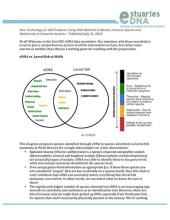
eDNA (environmental DNA) refers to the genetic material found in an environmental sample (water or sediment). eDNA comes from feces, gametes, scales, and cells that an organism sheds, and is easily collected from water and sediment samples. Rapid reductions in analytical costs now allow scientists to analyze eDNA in water samples and identify dozens of species without having to capture live animals or plants. A collaborative research project involving the University of New Hampshire and six National Estuarine Research Reserve sites developed and pilot tested eDNA sampling protocols that are suitable for use in highly variable estuarine conditions.
About this resource
As part of the collaborative project, the team developed periodic newsletters that present brief, user-friendly explanations of their preliminary results and current technical questions for the project. The newsletters provide an example of how a large team with a range of backgrounds can stay involved and engaged during a project. For the most recent updates and information, visit the eDNA pilot program website.
Newsletter archive:
- Newsletter #1 - eDNA at Wells & Hake - July 31, 2018
- Newsletter #2 - eDNA at Great Bay & River Herring - August 24, 2018
- Newsletter #3 - 18S Primer & Microscope Taxonomy - September 28, 2018
- Newsletter #4 - Sample Variance at Great Bay - October 11, 2018
- Newsletter #5 - Biodiversity Metrics from 18S - December 03, 2018
- Newsletter #6 - Primers & Oregon Lamprey - January 22, 2019
- Newsletter #7 - Metabarcoding vs. ddPCR - July 18, 2019
- Newsletter #8 - Where are the Green Crabs? - August 2019
- Newsletter #9 - Finding Fish in Great Bay - How many samples does it take? - June 2020
- Newsletter #10 - A Comparison of Sampling Methods for Larval Fish - August 2020
- Newsletter #11 - Assessing Restoration at He'eia Reserve - September 2020